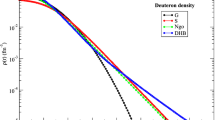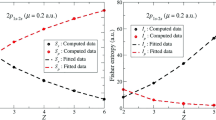Abstract
We propose a new mechanism for inducing low-energy nuclear reactions (LENRs). The process is initiated by a perturbation which we assumed to be caused by absorption or emission of a photon. Due to the electromagnetic perturbation, the initial two-body nuclear state forms an intermediate state to make a transition into the final nuclear state through the action of another perturbation. In the present paper, we take the second perturbation to be also electromagnetic. We need to sum over all energies of the intermediate state. Since the upper limit on this sum is infinity it is possible to get contributions from very high energies for which the barrier penetration factor is not too small. By considering a specific reaction, we determine the conditions under which this mechanism may lead to significantly enhanced reaction rates. We find that the mechanism leads to very small cross-sections in free space. However, in a condensed medium, there exist several possibilities leading to enhanced cross-sections, which may lead to observable reaction rates even at relatively low energies. Hence we argue that LENRs are possible and provide a theoretical set-up which may explain some of the experimental claims in this field.





Similar content being viewed by others
References
M Fleischmann and S Pons, J. Electroanal. Chem. Interf. Electrochem. 261, 301 (1989)
S E Jones et al, Nature 338, 737 (1989)
S E Koonin and M Nauenberg, Nature 339, 690 (1989)
A J Leggett and G Baym, Phys. Rev. Lett. 63, 191 (1989)
S B Krivit, Nuclear energy encyclopedia (John Wiley & Sons, Ltd., 2011), Ch. 41, p. 479
L I Urutskoev, Nuclear energy encyclopedia (John Wiley & Sons, Ltd., 2011), Ch. 42, p. 497
M Srinivasan, G Miley and E Storms, Nuclear energy encyclopedia (John Wiley & Sons, Ltd., 2011), Ch. 43, p. 503
J M Zawodny and S B Krivit, Nuclear energy encyclopedia (John Wiley & Sons, Ltd., 2011), Ch. 44, p. 541
W Williams and J Zawodny, Nuclear energy encyclopedia (John Wiley & Sons, Ltd., 2011), Ch. 45, p. 547
A Meulenberg, Curr. Sci. 108, 499 (2015)
A Takahashi, Curr. Sci. 108, 514 (2015)
K P Sinha, Curr. Sci. 108, 516 (2015)
C L Liang, Z M Dong and X Z Li, Curr. Sci. 108, 519 (2015)
E Storms, Curr. Sci. 108, 535 (2015)
M C McKubre, Curr. Sci. 108, 495 (2015)
J-P Biberian, Curr. Sci. 108, 633 (2015)
M Srinivasan and K Rajeev, Cold fusion (Elsevier, 2020), Ch. 13, p. 233
J-P Biberian, Cold fusion: Advances in condensed matter nuclear science (Elsevier, 2020)
A Huke, K Czerski, P Heide, G Ruprecht, N Targosz and W Żebrowski, Phys. Rev. C 78, 015803 (2008)
V Pines et al, Phys. Rev. C 101, 044609 (2020)
V Vysotskii and M Vysotskyy, EPJA 49, 08 (2013)
S Bartalucci, V I Vysotskii and M V Vysotskyy, Phys. Rev. Accel. Beams 22, 054503 (2019)
C Spitaleri, C Bertulani, L Fortunato and A Vitturi, Phys. Lett. B 755, 275 (2016)
P Kálmán and T Keszthelyi, Phys. Rev. C 99, 054620 (2019)
P Hagelstein, JCMNS 16, 46 (2015)
A Widom and L Larsen, EPJC 46, 107 (2006)
Y Srivastava, A Widom and L Larsen, Pramana – J. Phys. 75, 617 (2010)
J-L Paillet and A Meulenberg, JCMNS 29, 472 (2019)
H Assenbaum, K Langanke and C Rolfs, Z. Phys. A: Atomic Nuclei 327, 461 (1987)
S Ichimaru, Rev. Mod. Phys. 65, 255 (1993)
V A Chechin, V A Tsarev, M Rabinowitz and Y E Kim, Int. J. Theor. Phys. 33, 617 (1994)
J Kasagi, H Yuki, T Baba, T Noda, T Ohtsuki and A G Lipson, J. Phys. Soc. Jpn 71, 2881 (2002)
F Raiola et al, EPJA 19, 283 (2004)
K Czerski, A Huke, P Heide and G Ruprecht, The 2nd International Conference on Nuclear Physics in Astrophysics (Springer, 2006), p. 83
M Coraddu, M Lissia and P Quarati, Cent. Eur. J. Phys. 7, 527 (2009)
K Czerski et al, EPL 113, 22001 (2016)
T Schenkel et al, J. Appl. Phys. 126, 203302 (2019)
C Berlinguette et al, Nature 570, 45 (2019)
S Focardi et al, Condensed matter nuclear science (World Scientific, 2006), p. 70
E Storms and B Scanlan, JCMNS 11, 142 (2013)
L Holmlid and S Olafsson, Int. J. Hydrogen Energy 40, 10559 (2015)
M Srinivasan, JCMNS 15, 137 (2015)
N Packham et al, J. Electroanal. Chem. 270, 451 (1989)
E Merzbacher, Quantum mechanics (Wiley, 1998)
P Jain et al, JCMNS 35, 1 (2022)
D D Clayton, Principles of stellar evolution and nucleosynthesis (The University of Chicago Press, Chicago, 1968)
C A Bertulani, Nuclear physics in a nutshell (Princeton University Press, 2007)
H-S Bosch and G Hale, Nucl. Fusion 32, 611 (1992)
C A Bertulani and T Kajino, Prog. Part. Nucl. Phys. 89, 56 (2016)
P Jain, An introduction to astronomy and astrophysics (CRC Press, 2016)
J J Sakurai, Advanced quantum mechanics (Pearson Education, 1967)
A Dodonov and V Dodonov, Phys. Lett. A 378, 1071 (2014)
K P Rajeev and D Gaur, JCMNS 24, 278 (2017)
E Abrahams, 50 Years of Anderson localization (World Scientific, 2010)
P A Lee and T V Ramakrishnan, Rev. Mod. Phys. 57, 287 (1985)
J I Gersten and M H Mittleman, Phys. Rev. Lett. 48, 651 (1982)
Acknowledgements
The authors are very grateful to Mahadeva Srinivasan, Manoj Harbola, Amit Agarwal and Aditya Kelkar for useful discussions.
Author information
Authors and Affiliations
Corresponding author
Appendix
Appendix
In this appendix, we provide details of the angular integrals in the sum over energies in the intermediate state. We consider the initial state with \(S=1/2\), \(S_z=1/2\) and \(l=0\). The intermediate state has \(l=1\). With \(S=1/2\) and \(l=1\) we can form two states with \(j=3/2\) and \(j=1/2\). The states \(|j,j_z\rangle \) that are relevant for us are
where on the right-hand side the states are shown in notation \(|S,S_z;l,l_z\rangle \). Let us take the final photon direction to be along the z-axis, i.e. \({\hat{k}}_f = {\hat{z}}\). The corresponding polarisation vectors are along the \({\hat{x}}\)- and \({\hat{y}}\)-axes. Let us consider any one of the amplitudes appearing in eq. (32),
Since the initial state has \(l=0\), we can express this as
We have \(\vec {\epsilon }\,'_1\cdot {\hat{r}} = \sin \theta \cos \phi \) and \(\vec {\epsilon }\,'_2\cdot {\hat{r}} = \sin \theta \sin \phi \). The intermediate wave function \(\psi _n\) corresponds to \(l=1\). We get non-zero contributions only for \(\psi _n\sim Y_1^1\) and \(\psi _n\sim Y_1^{-1}\). Hence, we have four relevant combinations involving the two polarisation vectors and the two spherical harmonics. Let us consider one of these angular integrals, given by
In performing the integral over the polar angle \(\theta \) we keep only the leading-order contribution. We obtain
Here we have dropped terms of higher order in \(1/k_1 r\), which will be small since \(k_1\) takes rather large values. Similarly, we have the remaining integrals
and
We next consider the final-state matrix element
Let the initial photon momentum be
The corresponding polarisation vectors can then be taken as
By a suitable choice of coordinates, we can set \(\phi _i=0\). In any case, it will cancel out in the final result. We again find four relevant angular integrals in \({{\mathcal {M}}}_2\). These are
Let us now consider the case in which the initial and final polarizstion vectors are \(\vec \epsilon _1\) and \(\vec \epsilon \,'_1\). In this case, adding contributions from all the states in eq. (47), we obtain
where \(R_i\), \(R_n\) and \(R_f\) are the radial wave functions.
Rights and permissions
About this article
Cite this article
Jain, P., Kumar, A., Pala, R. et al. Photon-induced low-energy nuclear reactions. Pramana - J Phys 96, 96 (2022). https://doi.org/10.1007/s12043-022-02347-6
Received:
Revised:
Accepted:
Published:
DOI: https://doi.org/10.1007/s12043-022-02347-6
Keywords
- Low-energy nuclear reactions
- nuclear electromagnetic transitions
- Coulomb barrier
- nuclear fusion with two-photon emission




